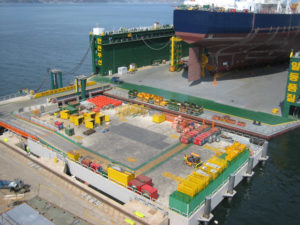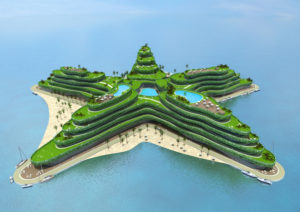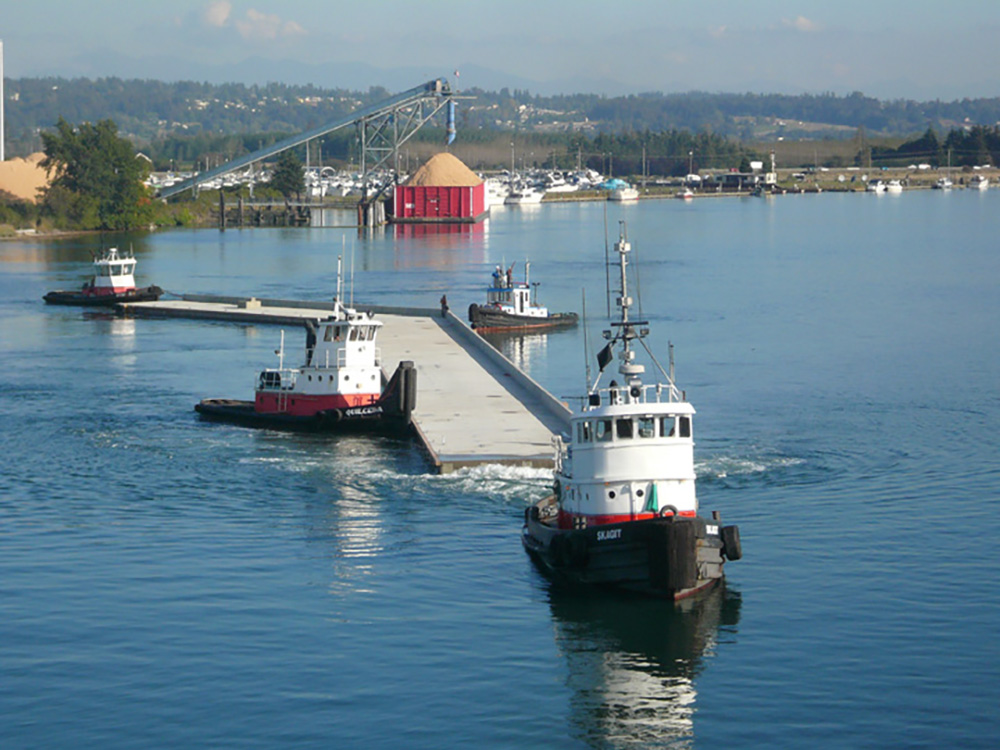Concrete floating breakwater being towed to its permanent location.
Values of waterfront property are typically higher than inland real estate for a variety of reasons but mostly due to desirability and market supply and demand. The desirability factor is obvious; who doesn’t want a nice view and cool breeze? However, the supply and demand for limited waterfront properties in modern coastal cities is also impacted by industrial (port terminals, warehouses, fuel storage), commercial (hotels, restaurants, retail), and recreational or other public waterfront uses (marina, waterfront park, trails and natural space).
This demand for use along metropolitan coastlines also results in congested, busy waterfronts with dense traffic leading to frustration and gridlock. Have you ever struggled to find a parking spot for shopping or dining in a large city’s waterfront district? We all have. So, is there a way to increase the area available for such valuable waterfront to mitigate density and enhance functionality? One solution is with floating waterfront facilities.
There are floating waterfront facilities currently built and in use across the world and even in our Puget Sound communities; coastal cities, including Seattle, Bremerton, Portland, San Diego, Vancouver, Hong Kong, and Singapore either currently have floating facilities or plan to have a Very Large Floating Structure (VLFS) in the near future.
Floating Concrete?
 Have you ever thought that concrete floats in water? We all know that ships made of steel heavier than water float; in similar fashion, a floating concrete facility with hollow compartments floats in water. Concrete is an excellent material to build a large size float, one that I highly recommend over steel. Unlike barge-like steel pontoon design requiring continuous maintenance similar to a typical ship, concrete construction offers a durable permanent facility with minimum maintenance. For a VLFS, you need a heavy duty design to accommodate uses requiring asphalt pavement or structural building columns, which would not work on a barge-like steel float. A durable floating facility made of modern concrete materials can last more than 100 years in a marine environment.
Have you ever thought that concrete floats in water? We all know that ships made of steel heavier than water float; in similar fashion, a floating concrete facility with hollow compartments floats in water. Concrete is an excellent material to build a large size float, one that I highly recommend over steel. Unlike barge-like steel pontoon design requiring continuous maintenance similar to a typical ship, concrete construction offers a durable permanent facility with minimum maintenance. For a VLFS, you need a heavy duty design to accommodate uses requiring asphalt pavement or structural building columns, which would not work on a barge-like steel float. A durable floating facility made of modern concrete materials can last more than 100 years in a marine environment.
A Few of the Benefits
The most important benefit to floating facilities is their cost-effectiveness as waterfront property. Another is flexibility. A floating structure can be built in a different place and installed at the proposed site within a short period time with minimal traffic disturbance. Design parameters, including size and shape of the floating structure, can be easily adjusted and customized, unlike fixed property with its many restrictions and limitations for changes. A floating structure also offers a friendly habitat for fish (as well as people). Unlike fixed structures, such as a breakwater or seawall, a floating facility does not disturb fish passage.
Current and Future Applications
 Floating waterfront facilities that provide an expanded waterfront area in communities today are ferry terminals, breakwaters, or piers. However, several countries are currently researching and planning designs for VLFS to support waterfront terminals, large residential communities, hotels, cruise ship terminals, oil storage operations, airports, military bases, clean renewable energy plants, amusement parks, etc.
Floating waterfront facilities that provide an expanded waterfront area in communities today are ferry terminals, breakwaters, or piers. However, several countries are currently researching and planning designs for VLFS to support waterfront terminals, large residential communities, hotels, cruise ship terminals, oil storage operations, airports, military bases, clean renewable energy plants, amusement parks, etc.
You and I will likely see these types of floating facilities in the near future. Futurists have expanded application of the floating facilities to include a floating city (island) and floating farm. It is predicted that there will be 20 million people residing on a marine floating city by 2050.


